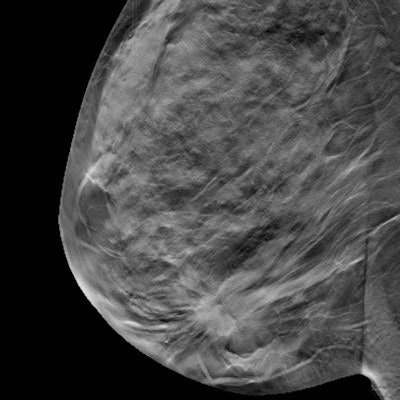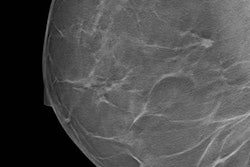
For women with mammographically negative dense breasts, double reading of digital breast tomosynthesis (DBT) plus synthesized 2D images is the most accurate of all DBT reading strategies. However, double reading also has the longest reading time, according to new research.
A study team from Italy compared six DBT strategies in women with mammographically dense breasts to determine which one was the most accurate. The highest accuracy came from double reading DBT with synthesized 2D images, according to Dr. Alberto Tagliafico, from the department of health sciences at the University of Genoa, and colleagues.
"We believe that our data may have implications for population breast cancer screening programs when deciding the screen-reading strategy, and may be useful for research planning," the study authors wrote (European Radiology, 22 June 2017).
Dealing with dense breasts
In breast cancer screening, imaging dense breasts presents a perennial problem. Mammography loses sensitivity for women with dense breasts, and these women have a higher risk of interval breast cancer, according to scientific literature. In light of this, adjunct screening methods have become all the more important. Ultrasound and DBT are the best contenders.
"Given the emergence of tomosynthesis in screening practice, and the relevance of adjunct screening for dense breasts, we performed a study that explores various strategies to use tomosynthesis for adjunct screening to assess cancer detection and to estimate reading time burden," the authors wrote.
The research is a substudy of the Adjunct Screening With Tomosynthesis or Ultrasound in Women With Mammography-Negative Dense Breasts (ASTOUND) trial, a prospective study to directly compare ultrasound and tomosynthesis for adjunct breast cancer screening after negative standard mammography in women with dense breasts. Previous results demonstrated that adjunct screening with tomosynthesis detected more than 50% of the additional breast cancers not detected at mammography, although ultrasound had significantly better incremental breast cancer detection than tomosynthesis in mammography-negative dense breasts.
Considering DBT's prowess, does one method of image interpretation work better than another? That's exactly what Tagliafico and colleagues sought to find out. They included 163 women who underwent DBT (Selenia Dimensions, Hologic) with synthesized 2D images generated from the tomosynthesis datasets rather than requiring the women to undergo a separate digital mammogram. The technique involved no additional radiation exposures beyond those of the tomosynthesis acquisitions. Of those women, 13 (7.9%) were diagnosed with breast cancer at histopathology after surgery.
Two readers compared the following:
- Single reading of synthesized 2D alone
- Single reading of tomosynthesis alone
- Single reading of joint interpretation of tomosynthesis plus synthesized 2D
- Double reading of synthesized 2D alone
- Double reading of tomosynthesis alone
- Double reading of joint interpretation of tomosynthesis plus synthesized 2D
The researchers found double reading of DBT and synthesized 2D images (S-2D) had an area under the curve (AUC) of 0.979 (p < 0.001) and a mean reading time of 154 seconds versus 34 seconds for the fastest strategy -- single reading of synthesized 2D alone. The AUCs of the other five strategies did not differ from each other.
| Performance of DBT imaging reading strategies | ||||||
| Single reading of S-2D alone (reader 1, reader 2) | Single reading of DBT alone (reader 1, reader 2) | Single reading of joint DBT + S-2D (reader 1, reader 2) | Double reading of S-2D alone | Double reading of DBT alone | Double reading of DBT + S-2D | |
| AUC | 0.907, 0.907 | 0.903, 0.869 | 0.952, 0.952 | 0.893 | 0.9 | 0.979 |
| Sensitivity | 94.44, 94.44 | 88.89, 88.89 | 94.44, 94.44 | 100 | 100 | 100 |
| Specificity | 86.9, 86.9 | 91.72, 84.83 | 95.86, 95.86 | 78.62 | 80 | 95.86 |
| Reading time | 31 seconds, 34 seconds |
43 seconds, 47 seconds |
75 seconds, 79 seconds |
65 seconds | 90 seconds | 154 seconds |
Interpretation of DBT alone or synthesized 2D alone, even with double reading, had the lowest accuracy estimates, so it follows synthesized 2D cannot be read alone without reading all images obtained by tomosynthesis.
The authors are evaluating the possibility of using DBT plus synthesized 2D on a regular basis at their institution, but they are quick to point out this study offers preliminary evidence.
"Given the nature of the study, the results should be interpreted as preliminary evidence, and further studies are needed," Tagliafico told AuntMinnieEurope.com.
He and his colleagues also stressed the accuracy calculations are merely for comparison and should not be taken as absolute values.



















